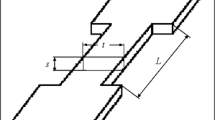Abstract
Coarse grained high purity aluminum was tested in creep at temperatures of 400° to 1200°F to develop subgrain structures. Measurements of subgrain size, distribution, and rotation were made from X-ray diffraction patterns. Subgrain size and distribution were checked metallographically and the size was compared with average slip band spacing. The slip family was determined for several specimens.
Similar content being viewed by others
References
C. H. M. Jenkins and G. A. Mellor: Investigation of the Behavior of Metals under Deformation at High Temperatures. Part I: Structural Changes in Mild Steel and Commercial Irons During Creep. Journal Iron and Steel Inst. (1935) 132, p. 179.
G. A. Homes: Recherches sur le mecanisme structural du comportement mecanique des metaux aux temperatures elevees. Revue de Metallurgie (1939) 36, p. 373.
H. Hirst: Deformation of Single Crystals of Lead by Creep. Part IV: Process of deformation during creep. Proc. Australasian Inst, of Mining and Metallurgy (1941) 121, p. 11.
E. A. Calnan and B. D. Burns: Some X-ray Observations of the Nature of Creep Deformation in Polycrystalline Aluminum. Journal Inst. Metals (1950) 77, p. 445.
G. R. Wilms and W. A. Wood: Mechanism of Creep in Metals. Journal Inst. Metals (1949) 75, p. 693.
W. A. Wood and W. A. Rachinger: The Mechanism of Deformation in Metals with Special Reference to Creep. Journal Inst. Metals (1949) 76, p. 237.
W. A. Wood and R. F. Scrutton: Mechanism of Primary Creep in Metals. Journal Inst. Metals (1950) 77, p. 423.
W. A. Wood, G. R. Wilms, and W. A. Rachinger: Three Basic Stages in the Mechanism of Deformation of Metals at Different Temperatures and Strain-Rates. Journal Inst. Metals (1951) 79, p. 159.
W. A. Wood, G. R. Wilms, and W. A. Rachinger: Authors’ answer to discussion. Journal Inst. Metals (1949) 75, p. 1138.
G. B. Greenough and E. M. Smith: The Mechanism of Creep as Revealed by X-ray Methods. Journal Inst. Metals (1950) 77, p. 435.
A. Guinier and J. Tennevin: Sur deux variantes de la methode de Laue et leurs applications. Acta Crystallographica (1949) 2, p. 133.
P. Lacombe and L. Beaujard: The Application of Etch-Figures on Pure Aluminum (99.99%) to the Study of Some Micrographic Problems. Journal Inst. Metals (1947) 74, p. 1.
G. Wyon and C. Crussard: Modifications de Structure de 1’aluminium au cours du fluage. Revue de Metallurgie (1951) 48, p. 121.
R. W. Cahn: Recrystallization of Single Crystals After Plastic Bending. Journal Inst. Metals (1949) 76, p. 121.
C. G. Dunn and F. W. Daniels: Formation and Behavior of Subboundaries in Silicon Iron Crystals. Trans. AIME (1951) 191, p. 147; Journal of Metals (February 1951).
R. W. Cahn: Slip and Polygonization in Aluminium. Journal Inst. Metals (1951) 79, p. 129.
I. S. Servi and N. J. Grant: Creep and Stress Rupture Behavior of Aluminum as a Function of Purity. Trans. AIME (1951) 191, p. 909; Journal of Metals (October 1951). Structure Observations of Aluminum Deformed in Creep at Elevated Temperatures. Trans. AIME (1951) 191, p. 917; Journal of Metals (October 1951).
P. A. Jacquet: Le polissage electrolytique des surfaces metalliques et ses applications. Editions Metaux Saint Germain-en-Laye (S. -et-O) (1948).
I. S. Servi and N. J. Grant: Metallographic Techniques for High Purity Aluminum. Trans. AIME (1951) 191, p. 473; Journal of Metals (June 1951).
E. Orowan: Origin and Spacing of Slip Bands. Nature (1941) 147, p. 452.
H. C. Chang and N. J. Grant: Observations of Creep of the Grain Boundary in High Purity Aluminum. Journal of Metals (June 1952) Trans. AIME, p. 619.
A. M. Gervais: Private communication.
C. S. Barrett: Structure of Metals. (1943) New York. McGraw-Hill Book Co.
Author information
Authors and Affiliations
Additional information
I. S. Servi, formerly Research Assistont, Massachusetts Institute of Technology
Discussion on this paper, TP 3345E, may be sent, 2 copies, to AIME by Dec. 1, 1952. Manuscript, March 24, 1952. Philadelphia Meeting, October 1952.
Rights and permissions
About this article
Cite this article
Servi, I.S., Norton, J.T. & Grant, N.J. Some Observations of Subgrain Formation During Creep in High Purity Aluminum. JOM 4, 965–971 (1952). https://doi.org/10.1007/BF03397754
Published:
Issue Date:
DOI: https://doi.org/10.1007/BF03397754




